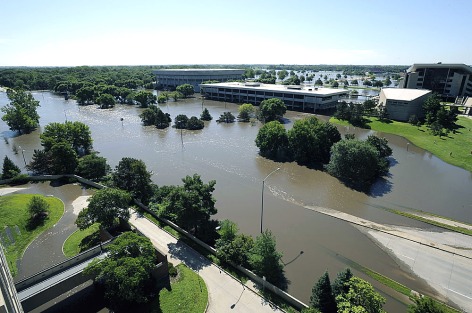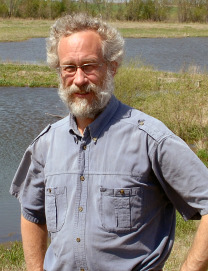
Researchers from Iowa State's College of Liberal Arts and Sciences will study and model the Squaw Creek watershed. One aspect of their study is to model how climate change could affect the rise and fall of creek levels. Here, Squaw Creek floods the Iowa State Center in August 2010. Larger photo. Photo by Bob Elbert.
AMES, Iowa – Squaw Creek was running fast and high through Ames just a few weeks ago. The early summer forecast called for even more rain. Flood crests and forecasts were once again in the news.
William Gutowski, whose campus office is just a few blocks from the creek, pulled back from his computer and started explaining how he and a team of researchers from Iowa State University’s College of Liberal Arts and Sciences will make Squaw Creek a model for planning sustainable water resources.
Their goal is to study water and climate change while reaching out to the community to build consensus for a sustainable water management plan. The study will focus on the Squaw Creek watershed in and around Ames, with the idea of making it a prototype that can be applied to other watersheds across Iowa and the world.
The researchers wrote in a project description that municipal, industrial, energy and agricultural interests in Iowa and beyond have competing water demands that are likely to grow in the face of changing climate and economic factors. Yet, they wrote, the available water in the upper Midwest also offers tremendous economic opportunity, if it is managed in a way that satisfies competing concerns.
The researchers also noted Squaw Creek is an ideal watershed to study the interaction of climate, hydrology and community needs because the project will build on decades of previous data collected by many on campus and in the community.
The researchers’ project is supported by a three-year, $300,000 grant from the College of Liberal Arts and Science’s Signature Research Initiative. The new initiative is designed to encourage college faculty to develop interdisciplinary research projects that can successfully compete for larger grants. The initiative recently awarded five projects related to the college’s five signature themes. The Squaw Creek project falls under the theme of economic, environmental and societal sustainability.
Gutowski, a professor of geological and atmospheric sciences, will lead the initiative and develop climate models for the project. He’s one of three Iowa State researchers who have been contributing to the Intergovernmental Panel on Climate Change, the international collaboration under the United Nations Environmental Program and the World Meteorological Organization that was awarded a share of the 2007 Nobel Peace Prize.
Other researchers and their project roles are:
- Kristie Franz, an associate professor of geological and atmospheric sciences, will model surface water processes.
- Jean Goodwin, a professor of English, will facilitate communication between scientists and water managers.
- Chris Rehmann, an associate professor of civil, construction and environmental engineering, will study environmental fluid mechanics and water resources engineering.
- William Simpkins, a professor of geological and atmospheric sciences, will model groundwater processes.
- Leigh Tesfatsion, a professor of economics, will model human behavior in the watershed and study economic policies and incentives governing water use.
- Alan Wanamaker, an assistant professor of geological and atmospheric sciences, will analyze past climate and water-cycle behavior.
“In climate studies, we typically run our computer models and put out the numbers,” said Gutowski. “But people see a bunch of numbers and say, ‘What the heck does all this mean?’”
The project – titled, “Water and Climate Change: Building Community Consensus for a Sustainable Future for Iowa and the World” – will address that problem in two primary ways:
The researchers will develop a prototype water-resources model for the Squaw Creek watershed that combines information about climate and hydrology with information about economics and human behavior. They’ll also use a process called Iterative Participatory Modeling to engage watershed decision-makers, stakeholders and scientists in ongoing discussions about the modeling and the implications of the model outcomes. The varied, experienced interests of Squaw Creek watershed community members will allow the research team to test the participatory approach with engaged and knowledgeable people.
By encouraging community engagement in the modeling process, the researchers hope to build consensus for a sustainable water management plan.
“We’re trying to integrate water modeling, climate modeling and community decision-making in a way that does justice to the perspectives each provides,” Gutowski said. “We’re looking for the best exchange of information and the best development of knowledge on how to manage our water resources as climate and water needs change.”
And Squaw Creek, even as it drops to its typically low and slow summer levels, really could affect water-resource planning around the world?
“We’ve talked about applying our project approach on a bigger scale,” Gutowski said. “Obvious extensions could cover the South Skunk River, or the Cedar or the Iowa rivers. A lot of my work involves interacting with people around the world and talking about water resources and the impacts of climate change. These techniques could be applied elsewhere.”
